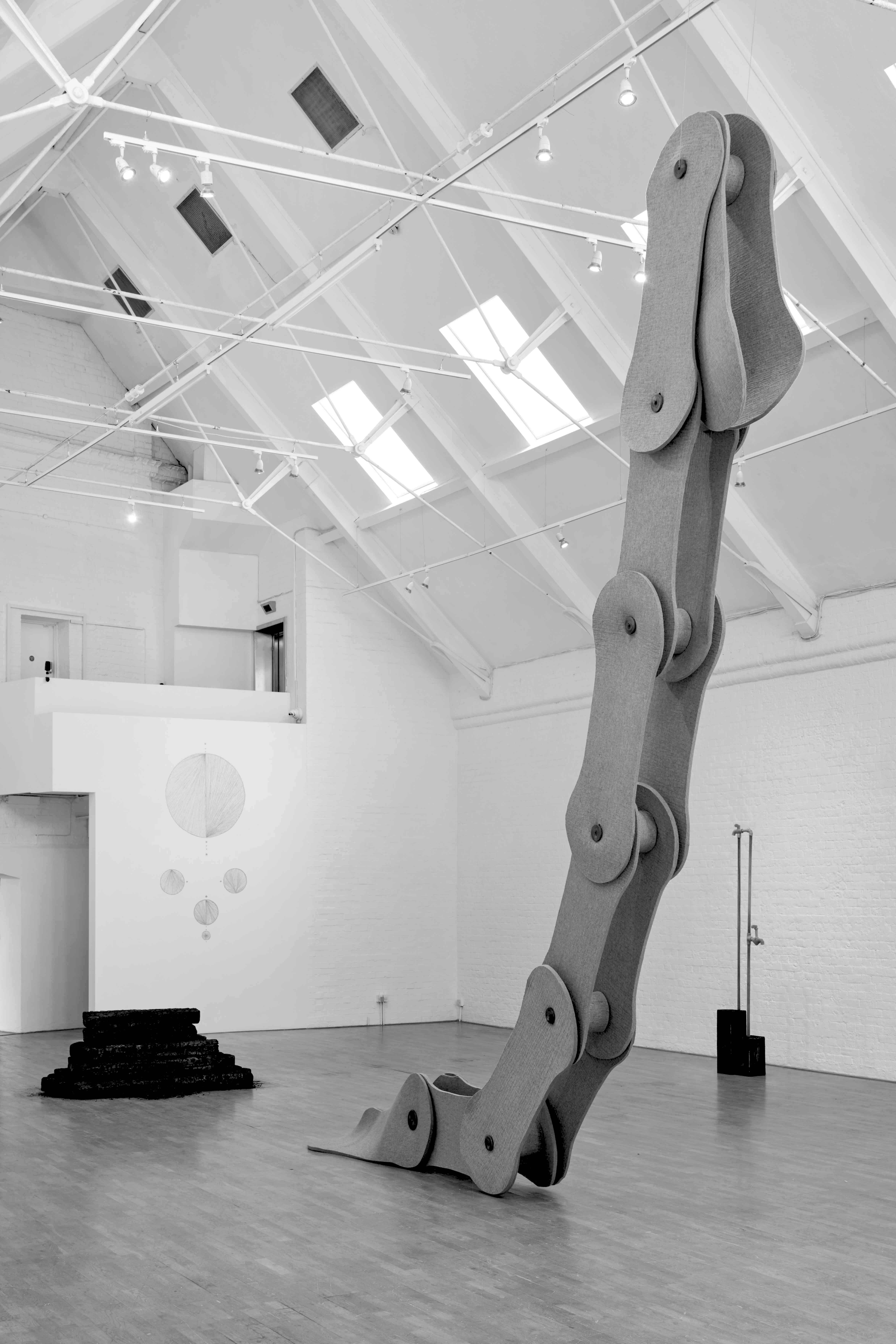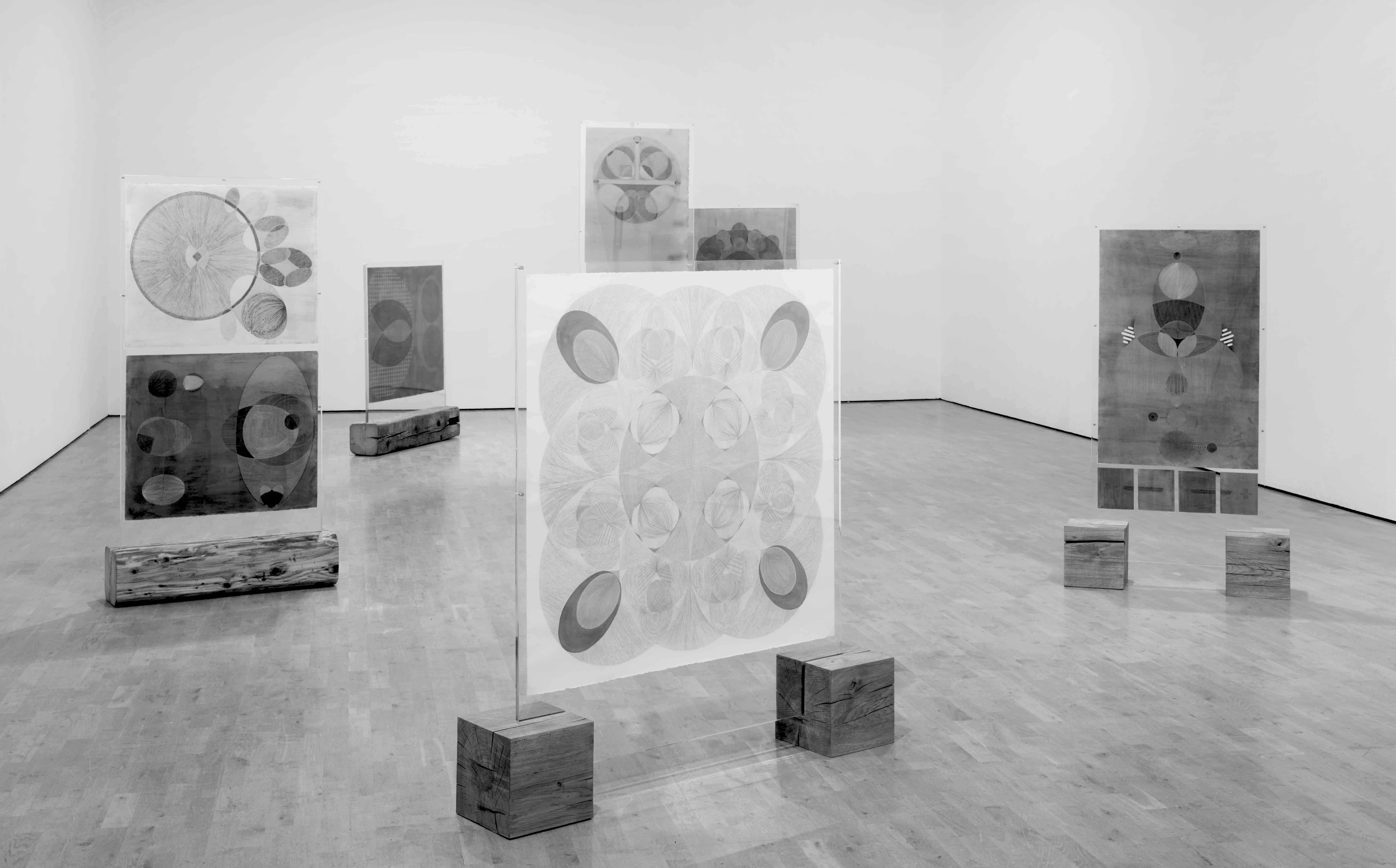Dr Lisandra Costiner
A review of Tools for Life by Johanna Unzueta at Modern Art Oxford (Virtual tour at https://www.modernartoxford.org.uk/event/tools-for-life/)
For Chilean artist Johanna Unzueta (b. 1974) the creation of art is a physical practice; hands become tools of production. We see and feel this in the artist’s first solo exhibition on British soil at Modern Art Oxford, open for exploration as a virtual tour after the closure of museums in March. Here, Unzueta recreates twisting pipes and water taps by carefully sewing fabric rather than welding metal, and assembles mechanical gears from pieces of felt pivoted on large wooden spools. The novelty of techniques and materials alongside Unzueta’s reshaping and physical engagement encourages the virtual visitor to draw, or rather zoom, closer and reconsider the production of everyday objects.

Fig.1 Installation view of Johanna Unzueta, Tools for Life at Modern Art Oxford, 2020. (Courtesy Modern Art Oxford; photograph Ben Westoby).
Growing up in Chile during the military dictatorship of Augusto Pinochet, in an era of privation and censorship, Unzuetta belongs to a generation of Latin American artists who relied on impermanent materials as a way of mounting and quickly disassembling artwork which commented on the regime. They relied on inexpensive materials such as cloth and cardboard and readily available tools, hands and the body, in the creation of art. The virtual tour, much like a personal visit, begins in the first and largest of the gallery’s three halls. It is a white-washed room bathed in light streaming from a half-dozen skylights cut into the pitched roof. In the middle, a nine-metre-high bicycle chain, Related to Myself 2019-2020 (Fig. 1), rises towards the ceiling, each link measuring the height of Unzueta’s body. ‘I like to say you have sixteen Johannas there’, the artist whimsically explains. It is an engagement with manufacture which weaves through the fabric of the exhibition. It continues into a side room, where a film about a Chilean wool factory is projected onto a cloth screen woven within that same facility. It threads further into the third hall dedicated to drawings traced with embroidery hoops and pinpricks, recalling the transfer of patterns in dressmaking.
Materials are central for Unzueta, not only due to the scarcity of resources following the coup d’état in Chile, but more so as evocations of inherent narratives of production, industrialisation, and sustainability. The artist sources felt from a family-run factory in Bavaria, scours flea markets in New York for giant spools, commissions hand-made wooden buttons from Mexico, and colours with natural indigo and fustic dyes used by the indigenous Mapuche community of Chile. It is an exhibition of excessive materiality, weight and presence, tantalising virtual visitors to reach out, touch, feel, set gears in motion and interact.

Fig.2 Installation view of Johanna Unzueta, Tools for Life at Modern Art Oxford, 2020. (Courtesy Modern Art Oxford; photograph Ben Westoby).
Whereas the first gallery relies on atypical materials, such as the aforementioned soft felt pipes, to encourage viewers to re-examine the production of familiar objects, the last gallery reverses the approach. Unfamiliar shapes, abstract geometric drawings, and pastel colours invite viewers to take note of the materials and techniques of artistic production. Natural dyes are layered to produce muted shades of blue, grey, and madder. They are washed over pastel geometric patterns, referencing a long history of geometric abstraction in Latin American art. The drawings are enclosed in Perspex, mounted onto wooden bases and displayed free-standing, so that one can meander through this forest of shapes and colours while pausing to take in their simplicity and fragility (Fig. 2). The freeing of drawings from the wall and the staging of each piece as a three-dimensional object arises from Johanna’s training as a sculptor. The display is also a nod to the iconic 1968 exhibition design of Italian-Brazilian architect, Lina Bo Bardi, at the São Paulo Museum of Art, which showcased paintings, mounted in glass anchored in concrete blocks, in the middle of the exhibition hall.
The titles of the drawings capture the date and location of their creation, September Berlin, November NY 2018, or December 2014, January, February, March 2015 NY, foregrounding the process of labour. The extensive time devoted to their creation derives from the natural processes used — natural dyes such as beetroots, onion skins, or anil indigo plants produce translucent shades, requiring repeated tinting of the paper to achieve deeper hues. These are layered by intricate patterns, parallel lines and herringbone weaves, recalling again Unzueta’s preoccupation with textiles. They also resemble motifs from the natural world, the structures of insect wings, the veins in leaves, or the layering of petals in flowers, further blurring the distinction between the natural and the manufactured.
In keeping with earlier exhibitions, Unzueta’s work is site-specific, created and situated in response to local architectural features and the present and past history of the gallery space. A Garment for the Day, 2019-ongoing, a coat rack with garments sewn from denim, up-cycled in a factory in Guatemala, resonates with the building of Modern Art Oxford, itself a former brewery now ‘re-purposed’ into an art gallery (Fig. 3). The coats, construed as ‘wearable sculptures’, were designed to the measurement of gallery staff who wore them on the exhibition’s opening night. Unzueta further weaves into the gallery’s history by drawing directly onto the bare exhibition walls. In Nocturnal, 2020, a room corner forms a seam across which a drawing, resembling an oversized heart, is mirrored. Circles with linear patterns float on the brick walls, akin to the interventions the artist made on the facade of the Zentrum für Kunst und Urbanistik (ZK/U) during the 2018 Berlin Biennale. Sketched with organic oil pastels and mineral pigments, these drawings will remain a part of the building’s layered history long after the exhibition closes its doors.

Fig.3 Installation view of Johanna Unzueta, Tools for Life at Modern Art Oxford, 2020. (Courtesy Modern Art Oxford; photograph Ben Westoby).
Although the life of the exhibition was cut short by the closure of museums across the U.K. in the wake of the current epidemic, its fleeting life reaffirms the show’s theme — the impermanence of nature and art. It closes with a message of hope: nature’s ability to regenerate and re-emerge as something new, equally mysterious and beautiful.

